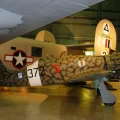
Macchi M.C.72 | |
|---|---|
| Country | Italy |
| Role | Seaplane racing aircraft |
| First flight | July 1931 |
| Built | 5 |
The Macchi M.C. 72 is an experimental seaplane designed and built by the Italian aircraft company Macchi Aeronautica. The M.C. 72 held the world speed record for all aircraft for five years. In 1933 and 1934 it set world speed records for piston engine-powered seaplanes; the latter still stands.
Source: Macchi M.C.72 on Wikipedia
| Macchi M72 Walk Around | |
|---|---|
| Photographers | Unknow |
| Localisation | Unknow |
| Photos | 33 |
See also:
The Macchi M.C. 72 was an experimental seaplane designed and built by the Italian aircraft company Macchi Aeronautica in the 1930s. It was powered by a modified Fiat AS.6 engine with two contra-rotating propellers and had a unique fuselage with metal and wood sections. The M.C. 72 was intended to compete in the Schneider Trophy race, but due to engine problems it never participated. However, it achieved fame by setting two world speed records for piston engine-powered seaplanes in 1933 and 1934, reaching a maximum speed of 709 km/h (440 mph). The latter record still stands today as the fastest speed ever attained by a propeller-driven aircraft over water.
The M.C. 72 was the result of a series of seaplanes developed by Macchi Aeronautica under the direction of designer Mario Castoldi. The company had won the Schneider Trophy in 1926 with the M.39, but failed to repeat its success with subsequent models such as the M.52, M.52R and M.67. Castoldi then designed the M.C. 72 as a single-seater monoplane with two floats and a streamlined fuselage that incorporated several radiators for cooling the water and oil of the powerful engine. The engine itself was a double-engine Fiat AS.6 that consisted of two AS.5 V12 engines mounted side by side and geared together. The engine produced about 2,500-3,100 hp (1,900-2,300 kW) and drove two three-bladed metal propellers that rotated in opposite directions to cancel out torque.
The development of the M.C. 72 was plagued by technical difficulties and delays, as well as tragic accidents that claimed the lives of two test pilots: Monti and Bellini. The aircraft was not ready for the final Schneider Trophy race in 1931, which was won by Britain for the third consecutive time. However, Macchi continued to work on improving the performance of the M.C. 72 with financial support from Benito Mussolini’s government. In April 1933, after 35 flights and several engine overhauls, Warrant Officer Francesco Agello piloted the M.C. 72 to a new world speed record over water of 682 km/h (424 mph), breaking Britain’s previous record of 655 km/h (407 mph) set by George Stainforth in a Supermarine S6B. A year later, on October 23rd, Agello improved his own record by reaching an astonishing speed of 709 km/h (440 mph) over Lake Garda. This feat made him an international celebrity and earned him several awards and honors.
The M.C. 72 remains one of the most remarkable achievements in aviation history, as well as one of the most beautiful examples of Italian design and engineering. It is widely regarded as one of Castoldi’s masterpieces, along with his later fighter aircraft such as the C202 Folgore and C205 Veltro. Only one surviving example of
the M.C. 72 exists today; it is preserved at the Italian Air Force Museum at Vigna di Valle near Rome.
Views : 1210





